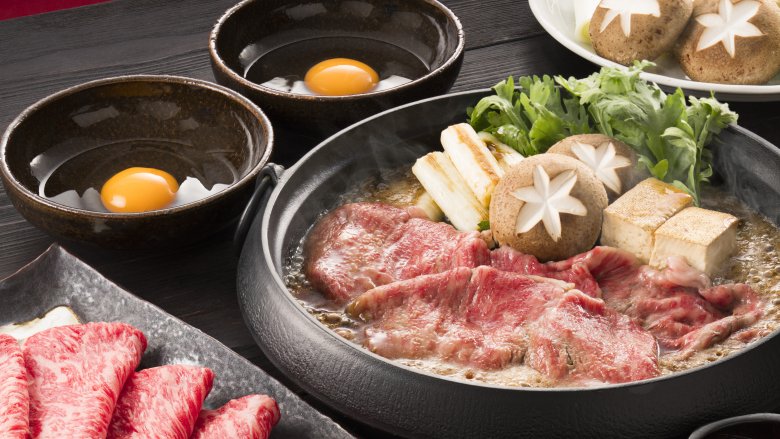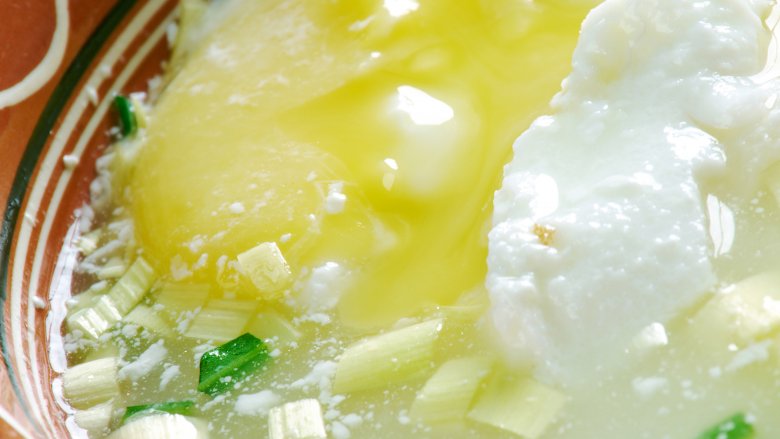How Other Parts Of The World Prepare Their Eggs
Eggs are pretty much a superfood. Loaded with nutrients and easily accessible, they're a popular source of protein all over the world, and are served in many different ways. The possibilities go way beyond scrambled and fried and, in many countries, are more than just a breakfast food! Here are some of the tastiest ways people prepare their eggs throughout the world — some of them may surprise you!
Japan
According to the International Egg Commission, the average person in Japan eats an average of nearly one egg per day for a total of 320 eggs each year! Egg consumption soared after WWII and became a staple in Japanese culture, with many egg-centric dishes becoming part of a typical Japanese diet.
One of the most intriguing breakfast dishes to come from Japan is tamagokake-gohan which consists of rice mixed with a raw egg and topped with soy sauce. Raw eggs are also used in other dishes, such as a dipping sauce for sukiyaki.
Colombia
In Colombia, soup is often on the menu for breakfast. Changua is a milk-based soup made with scallions, cilantro, and poached eggs. Bread can be served on the side or even mixed directly into the soup. The dish is especially popular in the capital city of Bogota. While changua is considered to be a breakfast food, it is hearty enough that it can really be eaten at any time of the day (or night)!
China
One of China's most famous (or infamous) delicacies is the century egg. The eggs aren't actually a century old as the name suggests, but they are aged. Century eggs (also sometimes called millennium or thousand year eggs) are preserved in a saline solution, a process which can take anywhere from a few weeks to several months. According to the Huffington Post, the preservation process "causes the yolk of the eggs to take on a creamy, cheese-like texture, and transforms the whites into a dark-colored jelly."
Philippines
Eggs are an important part of Filipino breakfasts. A popular dish in the Philippines is silog (derived from sinangag and itlog, the Tagalog words for "fried rice" and "egg"). Silog combines fried rice, eggs, and a meat for a delicious breakfast.
There are many common variations of this breakfast dish. Tapsilog adds cured meat to the dish, bangsilog incorporates bangus (milkfish), hotsilog uses hot dogs, and tinasilog is centered around tinapa (smoked fish).
England
Scotch eggs are all the rage in the United Kingdom and are common fare at English picnics. There are many ways to prepare this dish, but they usually include some sort of meat baked with bread crumbs around a hard-boiled egg. Vegetables are also often added to the mixture, and some modern recipes are vegetarian-friendly.
While the name suggests that the dish originated in Scotland, scotch eggs were in fact first created in England in the 18th century. They have since become a pub favorite and a cultural icon.
Korea
Korea's bibimbap is quickly catching on internationally, and for good reason. Bibimbap, which translates to "mixed rice," serves an entire meal in one bowl making it a go-to dish for multitaskers and people on the go.
The bowl starts off with rice and is then layered with sliced beef, sauteed veggies, sauces, and then topped with a raw egg. It is usually mixed together before eating, the raw egg holding all of the elements together.
Turkey
Menemen is a traditional Turkish egg-based dish. The main dish consists of scrambled eggs mixed with vegetables and spices, and is often served with a side of bread.
There are many ways to prepare this popular brunch item and it can be customized to anyone's taste. Some recipes call for spinach, and others go heavy on the cheese. It's the Middle Eastern equivalent of an omelet, the primary difference being that it uses scrambled eggs instead of fried.
Italy
Uova al pomodoro, also called eggs in purgatory, is a classic Italian comfort food originating in the region of Tuscany. Like many other traditional dishes from the country, uova al pomodoro incorporates tomato sauce which gives this recipe a decidedly Italian taste.
Preparing this food is quite simple, making it ideal for a quick meal. The eggs are poached in tomato sauce and then served. The dish can be garnished with herbs and garlic, and is commonly served up with a side of bread.
North Africa
Shakshuka (also spelled shakshouka) is North African dish which originated in the Ottoman Empire. The food is also common throughout the Middle East and Israel and has recently become an international culinary sensation lauded for its simplicity and universal appeal.
Regional variations of shakshuka can vary greatly. The highly adaptable dish uses eggs and tomatoes as its main base and can be enhanced with other vegetables, meat, or cheese. At its core, "shakshuka is basically baked eggs in sauce," says the director of New York's Umami: Food and Art Festival, Yael Raviv.
France
Eggs are a big deal in France and many people keep chickens in order to always have fresh eggs on hand. French supermarkets do not refrigerate their eggs, instead opting to keep a supply of freshly-laid eggs in stock.
Rather than being a breakfast staple, people in France typically serve eggs as a lunch or dinner dish. A popular and simple meal is a soft-boiled egg, served with thin sticks of buttered toast called mouillettes.
India
Egg masala is popular in India. The curry-based dish can be a little spicy, but it's rich and flavorful. It's often served alongside other Indian dishes, such as biryani and pulao.
There are many ways to prepare the dish, with seasonings varying. Eggs are generally boiled and kept whole and then added to the sauce. It's often served with a side of rice, which helps to soak up the thick and spicy sauce so that not a single drop is wasted.










